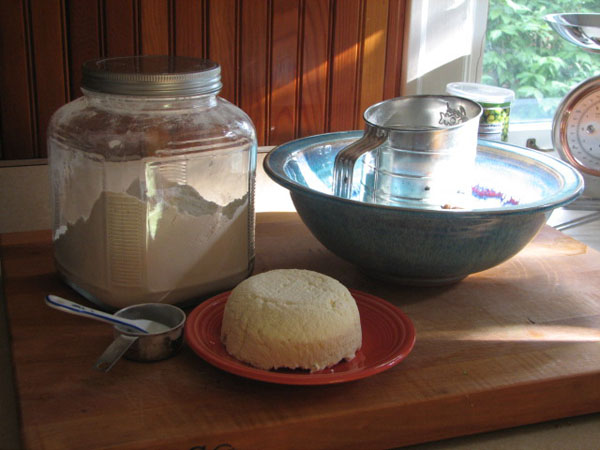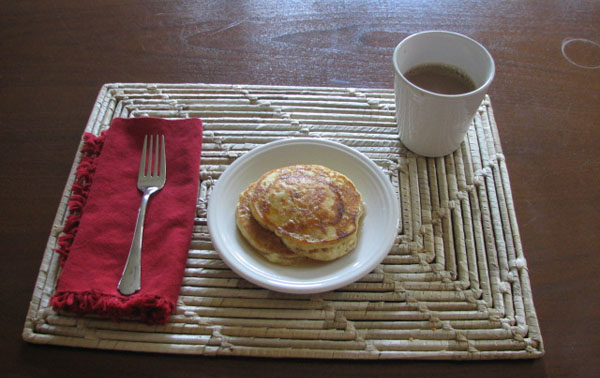
If you are thinking of taking up artisanal cheese making, ricotta is surely the easiest place to begin.
It takes about 20 minutes to make and it is eaten fresh, rather than aged, so gratification is nearly instant. And, like so many things, homemade ricotta is a remarkably different beast than the grainy, bland stuff oft found in grocery stores.
In Italian, ricotta simply means “re-cooked.” Technically, it’s not a real formaggio at all because, at least commercially, ricotta is made by cooking whey, a bi-product of cheese. If you don’t have a gallon or two of whey handy, you can make it from milk. In fact, one might argue that you should anyway: The extra protein and fat seem to do lovely things to the mouthfeel and flavor.

We’ve heard that cow milk produces sweeter but less tasty ricotta than either sheep or goat milk. So we used a mix of goat and cow milk, hoping to produce a cheese that was more flavorful yet not overwhelmingly goat-y (though we love the goat).
What we got was a mild and delightfully creamy ricotta — dry, but not gritty — with a little tang to it and only a slight sweetness. It more than held up on crackers and would likely have made a fantastic lasagna or cannoli, but we whisked it into pancakes, which it rendered light, fluffy and moist.
Fresh Homemade Ricotta
Adapted from a recipe by Richard Ferretti of Gourmet Magazine
Makes 2 cups
2 qts goat milk
1 c heavy cream
½ tsp salt
3 tbsp fresh lemon juice
Line a large sieve with a either heavy-duty cheesecloth or several layers of regular cheesecloth and place it over a large bowl.
Slowly bring milk, cream, and salt to a rolling boil in a heavy pot over moderate heat, stirring often to prevent scorching. Add lemon juice and reduce heat to low. Simmer, stirring constantly, until the mixture curdles, about two minutes.
Using a slotted spoon or an Asian skimmer, ladle the curds into the lined sieve and let them drain for one hour. Discard the whey and chill the ricotta in a covered container; it will keep in the refrigerator for two or three days.

Ricotta Pancakes
Makes 10 pancakes
1 c all-purpose flour
1 tsp baking powder
½ tsp baking soda
½ tsp salt
1 large egg
¾ c ricotta
1 c milk
2 tbsp butter
Sift together flour, baking powder, baking soda, and salt in a medium bowl.
Whisk together egg, ricotta, milk and butter. The ricotta should be fairly integrated but a little lumpy. Add flour mixture and stir until combined.
Heat a heavy skillet or griddle over a medium-high flame. Brush with butter and drop a quarter-cup of batter onto the pan for each cake; flip pancakes when the surface begins to bubble and cook until golden brown. This batter is heavy enough that it might not spread on its own; after you drop the batter on to the pan, spread it out gently with tip of your spatula.

I’ve only tried my hand at cheese once, fresh chive cheese, which the first steps of are exactly like this one however the recipe calls for 1 gallon whole milk and some additional steps after draining off the whey. Do you know if whole milk would work in place of the goat milk/heavy cream used here?
I make whole milk ricotta all the time (with cream) and love the results. I am looking forward to trying goats milk. The recipe I use is essentially the same as this one with whole milk instead of goats milk. Although I use ricotta in recipes, my favorite thing to do with it is to salt it and serve with Italian bread and roasted tomatoes and/or roasted peppers. Thanks for publishing this!
Kris, you can replace the goats milk in this recipe with cow milk. I haven’t tried it without the heavy cream, but I suspect it would work just fine — whole milk must have more protein and fat than leftover whey???